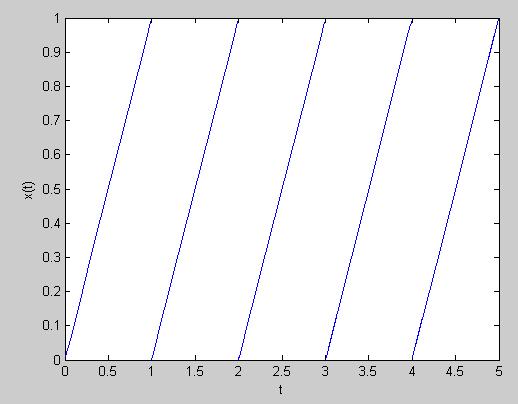(→Part 1) |
(→Part 2) |
||
| (8 intermediate revisions by the same user not shown) | |||
| Line 3: | Line 3: | ||
Sampling the signal at a frequency that is a rational multiple of the frequency of the signal will result in a periodic Discrete Time signal. Sampling the signal at a frequency that is not a rational multiple of the frequency of the signal will result in a non-periodic Discrete Time signal. | Sampling the signal at a frequency that is a rational multiple of the frequency of the signal will result in a periodic Discrete Time signal. Sampling the signal at a frequency that is not a rational multiple of the frequency of the signal will result in a non-periodic Discrete Time signal. | ||
| − | My all time favorite periodic signal- Sin(t) | + | My all time favorite CT periodic signal- Sin(t) |
| − | + | <pre> | |
t = 0:0.02:10; | t = 0:0.02:10; | ||
x = sin(t); | x = sin(t); | ||
plot(t,x) | plot(t,x) | ||
grid on | grid on | ||
| − | + | </pre> | |
[[image: SIN.jpg]] | [[image: SIN.jpg]] | ||
| − | Periodic signal turned Non-Periodic | + | Periodic signal turned Non-Periodic, DT non-periodic signal |
| − | + | <pre> | |
| − | [[image: | + | t = 0:0.5:10; |
| + | x = sin((1/(2*pi))*t); | ||
| + | plot(t,x) | ||
| + | grid on | ||
| + | stem(t,x) | ||
| + | </pre> | ||
| + | [[image: SINdt.jpg]] | ||
==Part 2== | ==Part 2== | ||
| − | Non-Periodic Signal | + | Non-Periodic Signal and Non-Periodic Signal turned Periodic |
| − | + | ||
| − | Non-Periodic Signal turned Periodic | + | Using x(t) = t |
| − | + | ||
| − | [[ | + | [[Image:Rampsjp_ECE301Fall2008mboutin.JPG]] |
| + | |||
| + | Using image from Jacob Pfister. | ||
Latest revision as of 16:10, 12 September 2008
Part 1
Periodic signal Sampling the signal at a frequency that is a rational multiple of the frequency of the signal will result in a periodic Discrete Time signal. Sampling the signal at a frequency that is not a rational multiple of the frequency of the signal will result in a non-periodic Discrete Time signal.
My all time favorite CT periodic signal- Sin(t)
t = 0:0.02:10; x = sin(t); plot(t,x) grid on
Periodic signal turned Non-Periodic, DT non-periodic signal
t = 0:0.5:10; x = sin((1/(2*pi))*t); plot(t,x) grid on stem(t,x)
Part 2
Non-Periodic Signal and Non-Periodic Signal turned Periodic
Using x(t) = t
Using image from Jacob Pfister.


